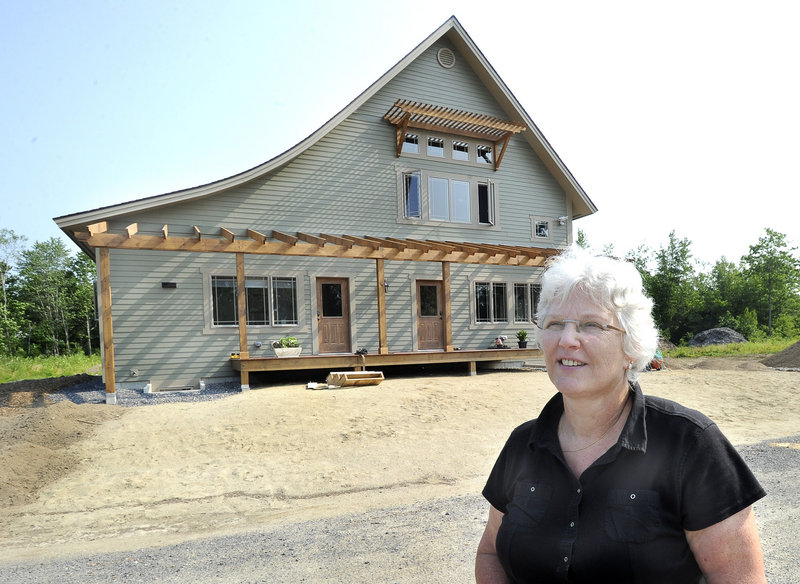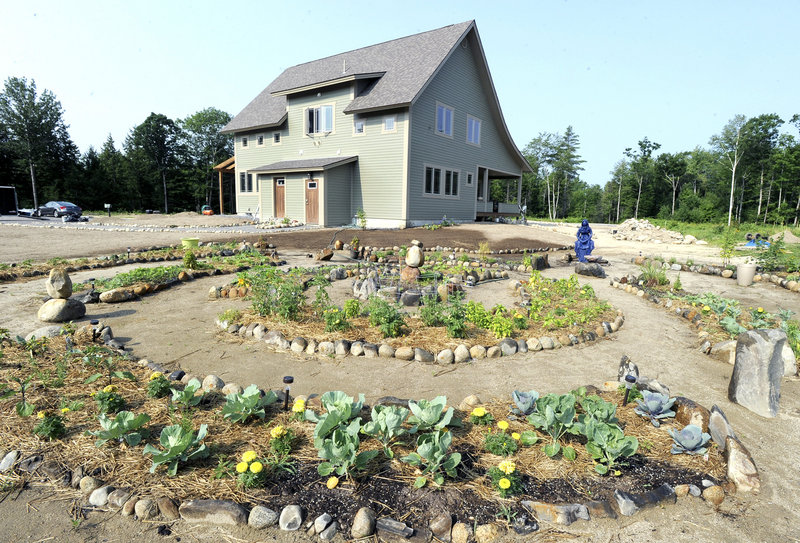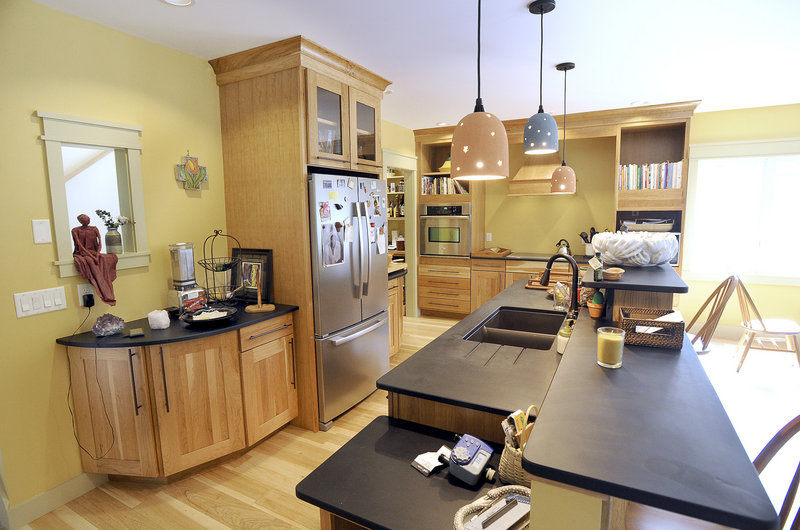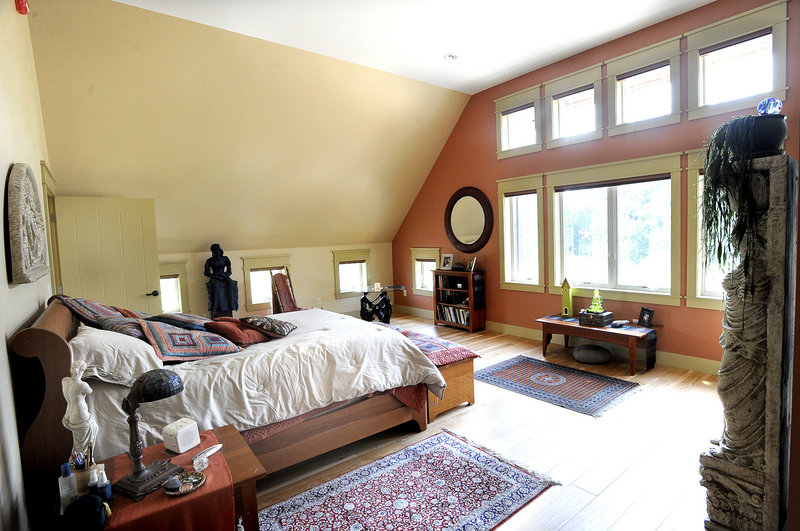BUXTON – Francoise Paradis is not, by trade, a real estate developer.
Yet she suddenly finds herself at the center of an effort to build a 20-unit cohousing community on eight acres of land she owns in Buxton, near Salmon Falls.
Paradis — a psychologist with a practice in Saco — says she has already sunk about $1 million into roads and infrastructure, plus the construction of the first two units.
She couldn’t get financing for more units, and she can’t be completely sure if the other units will sell or even when they’ll be built.
So the obvious question is: Why is she doing this?
“I decided I wanted to live in a community with people who shared my concerns about the environment, about making things right by using less,” said Paradis, 62. “I visited cohousing communities all over the country, and decided this is what I wanted to do. There’s a natural support system, and it uses a smaller footprint (than other development).”
Paradis is originally from Frenchville, in northern Aroostook County near Madawaska, and still has a trace of a French accent. She began raising a family and started her career in Presque Isle, where she and her husband built a solar home. When her children got older, Paradis moved to southern Maine. She bought a large parcel of land in Buxton plus a 4,000-square-foot house, where she planned to host mental health retreats.
But the retreat business didn’t get off the ground, and Paradis, now divorced, found that living in a big house by herself was not for her. So she sold the home, and is now using the money, plus her retirement savings, to fund the cohousing project.
Paradis said that while growing up in the 1960s, she became aware of the need for preserving resources and living in harmony as a society. She feels that now more than ever, people have to put their principles into action.
“I think we don’t have a choice in this country — we have to start pulling together and sharing resources,” she said.
Cohousing, in theory anyway, should allow people to do both. The units planned for Paradis’ community — called Greensward Hamlet — will be built in duplexes or four-unit buildings, so there will be a smaller footprint and less land used than if 20 single-family homes were built. All the homes — including the two already completed — will be built to extremely high energy-efficiency standards to trap as much solar heat as possible.
According to the Cohousing Association of the United States, cohousing is “a type of collaborative housing in which residents actively participate in the design and operation of their own neighborhoods.” They exist all over the United States, including some in Maine.
Part of Paradis’ planned cohousing community will include a community house with a kitchen, guest rooms, storage and office space to be shared by all. Responsibilities will be shared as well. Everyone in the community will have to do some chore that benefits everyone — cooking a group meal, bookkeeping, weeding or babysitting the children in the community, for example.
A cohousing community can help people feel less isolated and more needed, Paradis said. A retired person or senior citizen who otherwise might live in an apartment can get help from cohousing neighbors and feel useful by cooking a meal or watching someone’s children.
Paradis’ believes her target market for the cohousing units are retirees and single women.
“In my work, I see a lot of people my age who really miss a sense of community. People don’t have their children around them any more, or they are busy with their own lives,” said Paradis, who recently attended a national conference on cohousing. “And then there are people with disabilities who can’t work, but could contribute something to a cohousing community.”
All of the units will also include “universal design principles,” said Paradis and her contractor, Heather Jackson, of Jackson Built Inc. in Freeport. This means things are designed for easy use by children, the elderly and people with disabilities. Specifically, it means drawers and cabinets have long handles instead of knobs that are hard to grip. Hallways, stairwells and kitchen work spaces are extra wide to allow for wheelchairs, walkers and electric stair lifts.
The two units built so far are owned by Paradis and her daughter, Toni Morrison, and make up two sides of a duplex. Paradis’ unit is a fairly spacious one, with three to four bedrooms spread over two floors, while Morrison’s is a fairly small, one-story residence with one bedroom. Paradis says they represent the largest and smallest units that would be available.
The first thing that strikes one about the duplex is that it doesn’t look like a typical duplex, with two identical units attached to each other. And while multi-units are often very utilitarian, with very basic and cost-effective design features, this one is aesthetically creative.
For one thing, the building looks like a single-family house with a high-peaked A-frame roofline on one side that then drops down and forms a curved roof over the one-story portion.
The center of the second story — where Paradis’ master bedroom is — has a massive bank of four windows, with four more smaller windows over those, and a wooden pergola over those. There is also a pergola running the entire length of the back of the house, over the back porch.
The back of the house sort of looks like it should be the front of the house, since it has so many windows and doors. But the windows are there to capture the sun — and its heat — coming from that side. The front of the unit has fewer windows, and looks out onto a common area and to the fronts of other units.
The backs of the units will be where the roads are.
Paradis and Jackson paid the same attention to detail inside the units, with lots of woodwork, Mission-style windows and wood floors. But there are also nods to green design everywhere, including black kitchen countertops made of recycled materials and an electric-powered heating and air-conditioning unit.
Because the house is so tightly built, the unit uses relatively little electricity. Paradis says that with the AC unit on most of this summer, her electric bill has been only about $80 to $90 a month.
While the idea of cohousing might be appealing to some, and the units are tasteful and thoughtfully designed, Paradis acknowledges they will be a fairly hard sell in the current economy. Right now, a unit the size of hers would be priced at $425,000. Part of what makes the cost high is the cost of the common house and other common amenities, she said.
“I know that right now that price is high for this area,” said Paradis, who has had interest from people in her project but no other buyers.
To help defray costs for people who might want to be a part of her cohousing development, Paradis has started an organization call the Sustainable Lifestyles Foundation, and hopes to find grant money from private sources she can then use to help people buy a cohousing unit.
“I think if we can bring the price down, there will be more people who will be able to do this,” Paradis said.
Staff Writer Ray Routhier can be contacted at 791-6454 or at:
rrouthier@pressherald.com
Send questions/comments to the editors.






